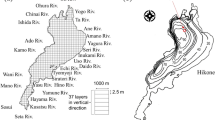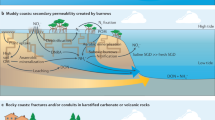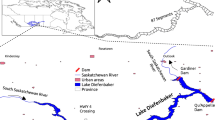Abstract
River water circulates vertically through the river bed and laterally through bank sediments1,2,3,4. This hyporheic exchange brings river water into contact with microbes in the adjacent sediments, otherwise known as the hyporheic exchange zone. As such, hyporheic zones act as hotspots for the biogeochemical cycling of carbon, metals and nutrients in rivers1,2,5,6,7,8, and can, for example, influence the export of nitrogen to downstream ecosystems5,9,10. Here, we calculate the extent and duration of lateral hyporheic exchange throughout the Mississippi River network, using a physics-based numerical model that takes into account the distribution of groundwater baseflow, river discharge, alluvium permeability and river morphology3,4. We find that in our simulations, lateral exchange occurs throughout the network: practically all of the river water that reaches the mouth of the Mississippi River network has circulated through the lateral hyporheic zone. River water residence time in the hyporheic zone ranges from less than an hour in headwaters to over a month in larger channels. Comparison of the residence times that we derive to a previously reported residence time threshold for denitrification suggests that around one quarter of the lateral hyporheic zones in the Mississippi River network favour denitrification, and thus nitrogen loss. Given that river water can circulate many times through the river bank before reaching the river mouth, and can undergo vertical exchange with the river bed, we suggest that our estimates serve as a lower limit for potential nitrogen loss.
This is a preview of subscription content, access via your institution
Access options
Subscribe to this journal
Receive 12 print issues and online access
$259.00 per year
only $21.58 per issue
Buy this article
- Purchase on Springer Link
- Instant access to full article PDF
Prices may be subject to local taxes which are calculated during checkout




Similar content being viewed by others
References
Boano, F., Demaria, A., Revelli, R. & Ridolfi, L. Biogeochemical zonation due to intrameander hyporheic flow. Wat. Resour. Res. 46, W02511 (2010)10.1029/2008WR007583
Gomez, J. D., Wilson, J. L. & Cardenas, M. B. Residence time distributions in sinuosity-driven hyporheic zones and their biogeochemical effects. Wat. Resour. Res. 48, W09533 (2012)10.1029/2012WR012180
Cardenas, M. A model for lateral hyporheic flow based on valley slope and channel sinuosity. Wat. Resour. Res. 45, W01501 (2009)10.1029/2008WR007442
Cardenas, M. Stream-aquifer interactions and hyporheic exchange in gaining and losing sinuous streams. Wat. Resour. Res. 45, W06429 (2009)10.1029/2008WR007651
Battin, T. J. et al. Biophysical controls on organic carbon fluxes in fluvial networks. Nature Geosci. 1, 95–100 (2008).
Boano, F., Camporeale, C., Revelli, R. & Ridolfi, L. Sinuosity-driven hyporheic exchange in meandering rivers. Geophys. Res. Lett. 33, L18406 (2006)10.1029/2006GL027630
Mulholland, P. J. et al. Stream denitrification across biomes and its response to anthropogenic nitrate loading. Nature 452, 202–246 (2008).
Fischer, H., Kloep, F., Wilzcek, S. & Pusch, M. T. A river’s liver—microbial processes within the hyporheic zone of a large lowland river. Biogeochemistry 76, 349–371 (2005).
Stewart, R. J. et al. Separation of river network-scale nitrogen removal among the main channel and two transient storage compartments. Wat. Resour. Res. 47, W00J10 (2011)10.1029/2010wr009896
Ye, S. et al. Dissolved nutrient retention dynamics in river networks: A modeling investigation of transient flows and scale effects. Wat. Resour. Res. 48, W00J17 (2012)10.1029/2011wr010508
Ensign, S. H. & Doyle, M. W. Nutrient spiraling in streams and river networks. J. Geophys. Res. 111, G04009 (2006)10.1029/2005jg000114
Fisher, S. G., Grimm, N. B., Marti, E., Holmes, R. M. & Jones, J. B. Material spiraling in stream corridors: A telescoping ecosystem model. Ecosystems 1, 19–34 (1998).
Covino, T., McGlynn, B. & Mallard, J. Stream-groundwater exchange and hydrologic turnover at the network scale. Wat. Resour. Res. 47, W12521 (2011)10.1029/2011wr010942
Turner, R. E. & Rabalais, N. N. Coastal eutrophication near the Mississippi river delta. Nature 368, 619–621 (1994).
Seitzinger, S. P. et al. Nitrogen retention in rivers: model development and application to watersheds in the northeastern USA. Biogeochemistry 57, 199–237 (2002).
Wollheim, W. M., Voosmarty, C. J., Peterson, B. J., Seitzinger, S. P. & Hopkinson, C. S. Relationship between river size and nutrient removal. Geophys. Res. Lett. 33, L06410 (2006)10.1029/2006gl025845
Alexander, R. B., Smith, R. A. & Schwarz, G. E. Effect of stream channel size on the delivery of nitrogen to the Gulf of Mexico. Nature 403, 758–761 (2000).
Peterson, B. J. et al. Control of nitrogen export from watersheds by headwater streams. Science 292, 86–90 (2001).
Soar, P. J. & Thorne, C. R. Channel Restoration Design for Meandering Rivers. Report No. ERDC/CHL-CR-01-1, 454 (US Army Corps of Engineers, 2001)
Kaufmann, P. R., Levine, P., Robison, E. G., Seeliger, C. & Peck, D. V. Quantifying Physical Habitat in Wadeable Streams. Report No. EPA/620/R-99/003, 149 (US Environmental Protection Agency, 1999)
Shepherd, R. G. Correlations of permeability and grain-size. Ground Wat. 27, 633–638 (1989).
Lu, C. P., Chen, X. H., Cheng, C., Ou, G. X. & Shu, L. C. Horizontal hydraulic conductivity of shallow streambed sediments and comparison with the grain-size analysis results. Hydrol. Proc. 26, 454–466 (2012).
Paulsen, S. G. et al. Condition of stream ecosystems in the US: An overview of the first national assessment. J. N. Am. Benthol. Soc. 27, 812–821 (2008).
Stoddard, J. L. et al. An Ecological Assessment of Western Streams and Rivers. Report No. 620/R-05/005, (US Environmental Protection Agency, 2005)
Wada, Y. et al. Global depletion of groundwater resources. Geophys. Res. Lett. 37, L20402 (2010)10.1029/2010gl044571
Zarnetske, J. P., Haggerty, R., Wondzell, S. M., Bokil, V. A. & Gonzalez-Pinzon, R. Coupled transport and reaction kinetics control the nitrate source-sink function of hyporheic zones. Wat. Resour. Res. 48, W11508 (2012)10.1029/2012WR011894
Zarnetske, J. P., Haggerty, R., Wondzell, S. M. & Baker, M. A. Dynamics of nitrate production and removal as a function of residence time in the hyporheic zone. J. Geophys. Res. 116, G01025 (2011)10.1029/2010JG001356
Gu, C. H., Hornberger, G. M., Mills, A. L., Herman, J. S. & Flewelling, S. A. Nitrate reduction in streambed sediments: Effects of flow and biogeochemical kinetics. Wat. Resour. Res. 43, W12413 (2007)10.1029/2007WR006027
Pinay, G., O’Keefe, T. C., Edwards, R. T. & Naiman, R. J. Nitrate removal in the hyporheic zone of a salmon river in Alaska. Riv. Res. Appl. 25, 367–375 (2009).
Acknowledgements
M.B.C. thanks the NSF (grant EAR-0955750) for support. The Geology Foundation at the University of Texas at Austin provided additional support.
Author information
Authors and Affiliations
Contributions
M.B.C. conceived this study with input from B.A.K. The data analysis, compilation and modelling were performed by B.A.K. The paper was written by M.B.C. with input from B.A.K., and both authors interpreted the results.
Corresponding author
Ethics declarations
Competing interests
The authors declare no competing financial interests.
Supplementary information
Supplementary Information
Supplementary Information (PDF 10953 kb)
Rights and permissions
About this article
Cite this article
Kiel, B., Bayani Cardenas, M. Lateral hyporheic exchange throughout the Mississippi River network. Nature Geosci 7, 413–417 (2014). https://doi.org/10.1038/ngeo2157
Received:
Accepted:
Published:
Issue Date:
DOI: https://doi.org/10.1038/ngeo2157
This article is cited by
-
Validation of an analytical model of groundwater velocity based on laboratory test and numerical simulation
Environmental Earth Sciences (2023)
-
Characterizing seasonal recharge between a river and shallow aquifer in a floodplain based on time-lapse electrical resistivity tomography
Hydrogeology Journal (2023)
-
Key technologies and equipment for contaminated surface/groundwater environment in the rural river network area of China: integrated remediation
Environmental Sciences Europe (2021)
-
Hierarchical climate-driven dynamics of the active channel length in temporary streams
Scientific Reports (2021)
-
Using water temperature series and hydraulic heads to quantify hyporheic exchange in the riparian zone
Hydrogeology Journal (2019)



